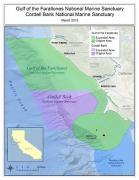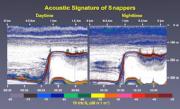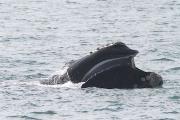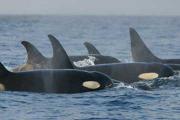Radio Program
Our regular Science and the SeaTM radio program presents marine science topics in an engaging two-minute story format. Our script writers gather ideas for the radio program from the University of Texas Marine Science Institute's researchers and from our very popular college class, Introduction to Oceanography, which we teach to hundreds of non-science majors at The University of Texas at Austin every year. Our radio programs are distributed at to commercial and public radio stations across the country.
Any marine creature that wants a bit of privacy would be well advised to avoid Cordell Bank, a submerged mound off the coast of northern California. Life is so abundant that, in places, corals, sponges, crabs, sea stars, and other organisms pile atop each other two or three deep, covering every square foot of sea floor. Fish fill the water above them, with whales and other mammals passing through as well.
In fact, Cordell Bank is one of the busiest marine habitats in the world. And it recently received some extra protection.
The oceans are getting louder. Fish and mammals grunt, click, and chirp to attract mates, threaten rivals, or just say “howdy.” At times, though, they can be overpowered by the sounds created by humans. It’s enough to drive a fish to distraction.
To understand just how distracting human-made noise can be, scientists first must understand how marine organisms deal with the natural “soundscape” — the sounds produced by the creatures themselves. A recent study, for example, found that fish seem to talk over each other during the daytime, but share the soundscape at night.
More than 2,000 years ago, a Roman ship was headed home with an amazing array of treasures when it sank off a Greek island. Today, scientists are exploring the wreck with an amazing array of technologies — including the “Iron Man” of the deep.
Researchers may not be ready to hold a conversation with them just yet, but they say they can identify a small group of right whales just by the sounds of their voices. That may provide new insights into the behavior of these endangered giants.
When a major oil spill takes place at sea, a whole army of experts and volunteers mobilizes to clean things up. The teams use several techniques to soak up the oil, suck it up, or even gobble it up. And in a few years, they may be able to add one more weapon to their arsenal: a type of net that captures the oil but allows water to flow right through.
For those of us who have a tough enough time getting around on two legs, trying to coordinate eight limbs sounds just about impossible. Yet the octopus does it all the time — it uses eight “arms” to crawl across the ocean floor. And some recent research says that crawling motion may not be all that complicated — the octopus decides which way it wants to go, then just pushes off.
Scientists recorded the motions of crawling octopuses, then looked at the video frame by frame. And they found that there are two keys to the way an octopus crawls.
In September of 1938, a monster hurricane roared across New York and New England. Sustained winds topped 120 miles per hour, and a massive storm surge flooded cities and towns. The storm killed about 600 people and, in today’s dollars, caused more than $40 billion in damages.
You can find creatures on the bottom of the ocean that’ll eat just about anything — from the poop of other organisms to minerals that bubble up from below the ocean floor. Even so, the diet of one type of crustacean is a bit of a surprise. That’s because it feeds on something you wouldn’t expect to find on the ocean floor: wood.
Some giant sheets of ice off the coast of Antarctica are disappearing like ice cubes being emptied from a stack of trays in your freezer. The first tray was emptied two decades ago, a second followed a few years later, and a third may go by the end of the decade.
These “trays” are parts of the Larsen Ice Shelf. It reaches into the Weddell Sea from a narrow finger of land that extends toward South America.
In many human cultures, the elderly have been respected as sources of knowledge and experience. And one non¬-human culture seems to revere its elders as well: a population of killer whales. In fact, they’re most likely to follow an older female when times are tough.
Female orcas can give birth between the ages of about 12 and 40. But unlike many other mammals, which don’t live beyond their childbearing years, female orcas can live into their 80s or 90s.












